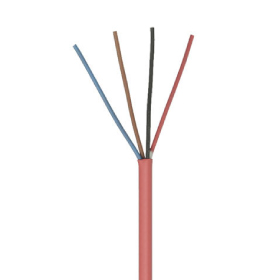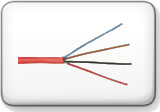
NEC Article 760:
NEC Article 760 covers the installation of wiring and equipment of fire alarm systems, including all circuits controlled and powered by the fire alarm system.These systems are defined in the NEC as "The portion of the wiring system between the load side of the overcurrent devices or the power-limited supply and the connected equipment of all circuits powered and controlled by the fire alarm system."
POWER-LIMITED FIRE ALARM SYSTEM CABLES:
1.Type FPL- FPL power-limited fire alarm cable is listed by the NEC as being suitable for general purpose fire alarm use. This listing excludes installation in riser, ducts, plenums and other spaceused for environmental air unless the cable is installed in conduit. All FPL cables are listed as being resistant to the spread of fire and must pass both UL test 1424 and the vertical flame test UL 1581.
2.Type FPLR- FPLR power-limited fire alarm riser cable is listed as being suitable for use in a vertical run in a shaft or from floor to floor. All FPLR cables are listed as having fire-resistant characteristics capable of preventing fire from traveling from floor to floor. Riser cables must pass both UL test 1424 and the Vertical riser test UL 1666.
3.Type FPLP- FPLP power-limited fire alarm cable is listed by the NEC as being suitable for usein ducts, plenums and other space used for environmental air. All FPLP cable are listed as having adequate fire resistant and low-smoke producing characteristics and must pass both UL test 1424 and UL Stiener tunnel test 910. (NFPA262)
o No Voltage Rating Markings on PLFA Cables
o CL3 and CM rated cables, which have a voltage rating of 300V are permitted to be used as PLFA cables.
o Power-limited is inherently limited by the power supply
o Transformer
o Other Power Supply Devices
NON POWER-LIMITED FIRE ALARM SYSTEM CABLES:
1.Type NPLF- NPLF Non power-limited fire alarm cable is listed by the NEC as being suitable for general purpose fire alarm use. This listing excludes installation in riser, ducts, plenums and other space used for environmental air unless the cable is installed in conduit. All NFPL cables are listed as being resistant to the spread of fire and must pass both UL test 1424 and the vertical flame test UL 1581.
2.Type NPLFP- NPLFP Non power-limited fire alarm cable is listed by the NEC as being suitable for use in ducts, plenums and other space used for environmental air. All NPLFP cable are listed as having adequate fire resistant and low-smoke producing characteristics and must pass both UL test 1424 and UL Stiener tunnel test 910.(NFPA262)
o Power source of NPLFA circuits output voltage shall not exceed 600 volts Nominal
o Marking on NPLF cables are not addressed as 150V. For use in 150V or less on NPLF circuits (out of tray or conduit)
o Class 1 cables can be installed and used as NPLFA, but must be placed in a tray or conduit.
o Overcurrent devices shall be located at the point where the device to be protected receives its supply.
CONVENTIONAL ( STANDARD) FIRE ALARM SYSTEM
Conventional Fire Alarm Systems, in their various forms, have been around for many of years and have changed little in that time in terms of technology although design and reliability have impoved significantly. However, Conventional systems are a well proven technology protecting many hundreds of thousands of properties worldwide. A Conventional Fire Alarm System is often the natural choice for smaller systems or where budget constraints exist. In a Conventional Fire Alarm System the "Intelligence" of the system resides solely within the Fire Alarm Control Panel. The panel receives a trigger signal from a Conventional Detector or Initiating Device Circuit (Smoke, heat, flame detectors) which in turn signals the condition to the Notification (Indicating) Device Circuit such as alarm sounders, horns, strobes and other remote signalling equipment. Conventional detectors are normally connected to the Fire Control Panel via dedicated circuits, each circuit protecting a designated "Zone"or area of the building. The system has different modes: Normal, Alarm, Trouble, and others, depending on the Fire Alarm Manufacturer.
CONVENTIONAL FIRE ALARM CABLE SELECTION
The designer must be sure that the last device on the circuit has sufficient voltage to operate the device within its rated voltage. When calculating the voltage available to the last device, it is necessary to consider the voltage drop due to the resistance of the wire. The larger the wire, the less the voltage drop. Generally, for purposes of determining the wire size necessary for the system, it is best to consider all of the devices as "lumped"on the end of the supply circuit, this simulates the worst case.
Typical wire size resistance: Loop Resistance
18 AWG solid: Approximately 6.5ohms/1000ft. 13ohms/1000ft.
16 AWG solid: Approximately 4.1ohms/1000ft. 8.2ohms/1000ft.
14 AWG solid: Approximately 2.6ohms/1000ft. 5.2ohms/1000ft.
12 AWG solid: Approximately 1.8ohms/1000ft. 3.6ohms/1000ft.
EXAMPLE:
Assume you have 10 devices on a zone and each require 50mA average and 2000 ft. of 14 AWG wiring. The voltage drop at the end of the loop is .050 amps per device x 10 devices x 2.6?/1000ft x 2000 = 2.6 V.A 12 AWG would produce a drop 1.8 V, and a 18 AWG would produce a voltage drop of 6.5 V.
Notes:
o If Class A wiring is installed, the wire length may be up to 4 times the single wire length in this calculation
o Consult your panel manufacturer´s specifications to determine acceptable voltage drop. Do not exceed panels specified amperage output
o All wiring must be installed in compliance with the National Electrical Code (NEC) and applicable local codes, as well as special requirements of the authority having jurisdiction, using the proper wire size.
ADDRESSABLE FIRE ALARM SYSTEM
Addressable Fire Alarm Systems differ from conventional systems in a number of ways and certainly add more flexibility, intelligence, speed of identification and scope of control. For this reason, Addressable Fire Alarm Systems are the natural choice for larger premises and buildings with more complex system requirements. In an Addressable system, detectors are wired in a loop around the building with each detector having its own unique address. The system may contain one or more loops depending upon the size of the system and design requirements. The Fire Control Panel communicates with each detector individually and receives a status report e.g Normal, Alarm, Trouble etc. As each detector has an individual address the fire alarm control panel is able to display or indicate the precise location of the device in question, which obviously helps speed the location of an incident and for this reason zoning of the system is not necessary, although it may be done for convenience. Addressable detectors are, in themselves, intelligent devices which are capable of reporting far more than just fire or fault conditions. Most analog addressable detectors are able to signal if contamination in the device reaches a pre-set level enabling maintenance to take place prior to problems being experienced. In most earlier styles of Addressable systems, the notification appliances were not intellegent. Today,many manufacturers are providing addressable notification technology. There are many advantages of providing such technology. Such as lower cost of wire, and overall installation time.
ADDRESSABLE FIRE ALARM CABLE SELECTION
The designer must be aware of not only the D.C Resistance of the cable, but the capacitance and the Velocity of propagation of the cable. The designer must assure that the overall loop capacitance is not compromised, and error rates are kept to a minimum.
Nominal Capacitance for wire sizes:
18 AWG solid unshielded: 16pf/ft
18 AWG solid shielded: 25pf/f t45pf/ft **
16 AWG solid unshielded: 18pf/ft
16 AWG solid shielded: 30pf/ft 54pf/ft **
14 AWG solid shielded: 30pf/ft. 54pf/ft **
12 AWG solid shielded: 35pf/ft. 63pf/ft ****
Capacitance between one conductor and the other connected to the shield.
Notes:
o If Class A wiring is installed, the wire length may be up to 4 times the single wire length in this calculation
o Consult your panel manufacturer´s specifications to determine acceptable loop capacitance.
o All wiring must be installed in compliance with the National Electrical Code (NEC) and applicable local codes, as well as special requirements of the authority having jurisdiction, using the proper wire size.
LOW AND MID CAPACITANCE CABLES:
ADDRESSABLE FIRE ALARM SYSTEM
The need to conform to the American with Disability Act (ADA), and the increased demand for addressable fire-alarm systems have created many changes in the fire-alarm cable constructions. An addressable system allows the control panel or unit to communicate with each base individually using a sophisticated polling process. The polling process allows the system to detect trouble, or alarm or each base initiating devices, and in some cases the notification devices. Addressable fire-alarm signals need to be fast and have a clear signal transfer. Hence the electrical characteristics are a major concern in cable construction. Capacitance-The property of a system of conductors and dielectrics that allow the storage of an electrical charge when a potential difference exists between conductors.Capacitance is found between two wires of a twisted pair, and also between adjacent conductors in the same cable (mutual capacitance). Capacitance is expressed in pf/ft. The larger the capacitance, the higher the distortions. Velocity of propogation-refers to a ratio of a signal traveling through a cable compared to that same signal traveling through air and is determined by the dielectric insulation material.
SYSTEM LAYOUTS:
The initiating circuits that connect detectors to a control panel should be supervised so that a fault (trouble) condition that could interfere with the proper operation of the circuit will be detected and annunciated. Detectors are generally categorized as either 2-wire or 4-wire detectors. Two-wire detectors derive their power directly from the same fire alarm control panel alarm initiating device circuit over which they report an alarm. Because of their dependency on the initiating circuit, 2-wire detectors must be tested and list-ed for compatibility with the control panel to be used, to ensure proper operation. Four-wire detectors are powered from a separate pair of wires, and like the 2-wire detector, apply anelectrical short across the associated alarm initiating device to transmit an alarm.Because they do not derive their power from the alarm control panel circuit, compatibility is predicated upon the operating parameters of the power supply to which the detectors are connected and not the initiating circuit.Supervision of the power to 4-wire detectors is mandated through the use of an end of line power super-vision relay (EOLR). When power is on, the relay contacts at the end of line relay are closed and con-nected in series with the end of line resistors beyond the last initiating device. Loss of power at anypoint in the power supply circuit will cause the relay to de-energize and a trouble condition to occur onthe initiating circuit.
CLASS B CIRCUITS: Class B circuits differentiate between short circuits across the loop ( alarm) and opens on the loop (trouble). Supervision of this circuit is accomplished by passing a low current through the installationwiring and an EOLR. Increases or decreases in this supervisory current are monitored by the fire alarm control panel and will cause alarm or trouble conditions, respectively, to be indicated. A single onpen ina Class B circuit disables all devices electrically beyond open.
CLASS A CIRCUITS: Class A circuits also differentiate between short circuits across the loop and opens on the loop. Supervision is accomplished by monitoring the level of current passing through the installation wiring and the EOLR, which in a Class A circuit is an integral part of the fire alarm control panel. Class A wiring must return to and be terminated in the control panel. This technique requires a minimum of fourwires be terminated in the control panel, and further requires that the fire alarm control panel is designed to monitor Class A circuits. The additional circuitry neccessary for Class A supervision enables the control panel to "condition" the initiating circuit to monitor the initiating circuit from both ends when in a trouble mode due to an open fault on the loop. This "conditioning"ensures that all devices are capable of responding and reporting an alarm despite a single open or non-simultaneous single ground fault on a circuit conductor.















